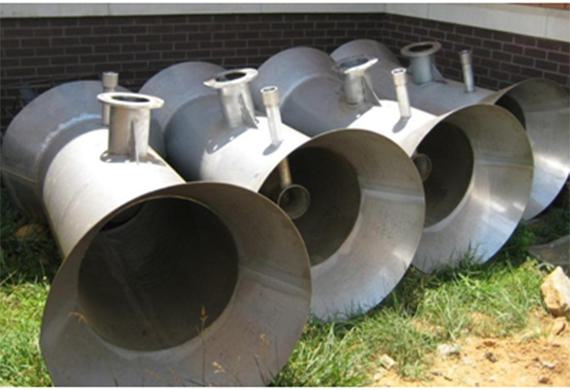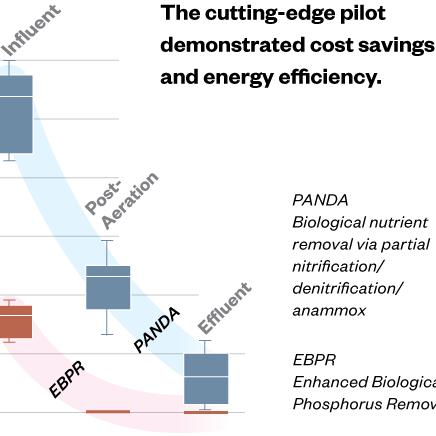Fats, Oils, and Grease (FOG) Removal
Innovative Approach for Pump Stations
The accumulation of fats, oil, and grease can bring wastewater treatment to a standstill. Hazen and Sawyer implemented innovative dispersion systems at two pump stations that eliminated costly, odor-causing accumulations - a cost quickly recovered through reduced wet well cleaning costs.
FOG (fats, oil, and grease) has always been present in wastewater, but more and more wastewater pump stations are affected by the buildup of significant quantities of FOG in the wet wells.
The buildup can be extreme - the layer of FOG at the water surface can be several feet thick, stealing usable working volume, causing odor problems, and creating a mess during peak flow events. In some cases, the surface mat dries out and hardens to the point where crews need shovels to break through the surface to obtain wastewater samples.
The accumulated debris is also a fire hazard. In one instance, hot slag from overhead welding dropped onto the hardened layer of FOG and ignited, resulting in a shutdown of the pump station and a unique extinguishing situation for the local fire department.
Removing the hardened FOG layer is costly and extremely odorous. Worse, the results of the cleaning operations are often short-lived, with a new FOG layer forming and accumulating again within days after cleaning.
Related Topics:


To better address FOG issues, Hazen and Sawyer has successfully utilized a Venturi-type customized FOG dispersion system at two large pumping stations in Metro-Atlanta, Georgia. The FOG dispersion systems are designed to create a strong surface agitation to break up accumulated debris and prevent the formation of a surface layer of FOG. The systems are installed in Gwinnett County’s 34-mgd Beaver Ruin Pump Station and Fulton County’s 95-mgd Riverside Road Pump Station. Prior to the FOG dispersion systems being installed, Beaver Ruin required about $60,000/year and Riverside Road more than $100,000/year in FOG cleaning operations, and both facilities suffered from poor performance and severe odor problems. The dispersion systems are simple and robust. They require minimal attention and maintenance, and work so effectively that both operating systems have already paid for themselves in reduced cleaning costs.


Beaver Ruin Pump Station
The Beaver Ruin Pump Station is a critical regional pump station in Gwinnett County’s collection and conveyance system. Since its startup in January 2002, the station has experienced numerous operational issues such as power outages, pump failures, pump deterioration, severe FOG buildup in the wet wells, excessive pump vibration, and multiple pump shaft failures resulting in higher than expected maintenance and repair costs. These issues have caused a number of pump station failures, compromising the reliability of the County’s collection and conveyance system.
Gwinnett County tasked Hazen and Sawyer to develop solutions to mitigate many of the pump station’s operational issues. Scaled physical modeling was utilized to evaluate pump inlet conditions, second stage piping, and the FOG dispersion system. The physical model simulated the hydraulic conditions starting at the entrance to the wet well and into the suction of the second stage pump. The modeling revealed several problems with the wet well hydraulics and the hydraulics to the second stage pumps. Problems included air entrainment from an upstream weir, poor approaches to the pump suction elbows that resulted in suction vortices, and a severe imbalanced-flow issue at the second stage pump suction that included flow reversal at the eye of the impeller.
The modeling also revealed that the wet well’s existing serpentine approach channels to the pumps were not effective at improving pump hydraulics and actually created traps that contributed to the station’s significant FOG accumulations. The modeling confirmed that removal of the serpentine approach channels and the installation of a FOG dispersion system would have no adverse effect on the operation of the primary wastewater pumps and would be effective at minimizing FOG accumulations.
The wet well’s configuration was modified to resolve the hydraulic issues and minimize FOG build-up. Modifications to resolve the FOG build-up problems and other operational issues at the station included:
- A Venturi-type FOG dispersion system and piping to prevent FOG accumulation
- Chopper-type motive pumps for the FOG dispersion system that also serve as wet well dewatering pumps
- New flow cones to minimize the promulgation of vortices at the suction bell
- Modification of the piping between the first and second stage pumps to remedy the flow imbalance issue
- Bio-scrubbers to control odors
- New vibration sensors to record vibrations in real time and protect the pumps before serious damage occurs
After a single day of continuous operation of the FOG dispersion system, FOG accumulation in the wet wells at the pump station was reduced to virtually nothing. The before and after photos of the Beaver Ruin wet well with the FOG Dispersion System operating show the dramatic and almost immediate results.


Riverside Road Pump Station
As part of a project to double the capacity of Fulton County’s Riverside Road Pump Station, Hazen and Sawyer was tasked to increase the reliability of the station, address odor issues, improve the aesthetics, and minimize FOG accumulation issues in the wet well. To remedy the FOG issues (which were also contributing significantly to the station’s odor issues, particularly during wet well cleaning operations), Hazen and Sawyer utilized Computational Fluid Dynamics (CFD) modeling to verify that a new FOG dispersion system would not impact the hydraulics of the six, 900-HP wastewater pumps installed as part of the project.
New submersible chopper pumps were installed in each wet well to act as both a wet well dewatering pump and as a motive pump for the FOG dispersion system. The new FOG dispersion system runs for 30 minutes every hour and has proven to be quite successful at minimizing and preventing FOG accumulations. The new FOG dispersion system and new odor control system have eliminated odor complaints associated with the station.
Cost-Effective Solutions
The custom-designed FOG dispersion systems for these two pump stations have proven to be cost-effective at minimizing and preventing odorous and disruptive accumulations of FOG within the wet well. Rather than accumulating within the wet well, the FOG is sent with the pumped wastewater to the downstream wastewater treatment plant where it can be properly handled and disposed.
Venturi-type FOG dispersion systems are custom- designed solutions that are optimal for large pumping stations with deep wet wells; however, similar solutions can be developed for smaller wet wells and in wastewater treatment plants that may have scum accumulation problems in distribution boxes or channels.











